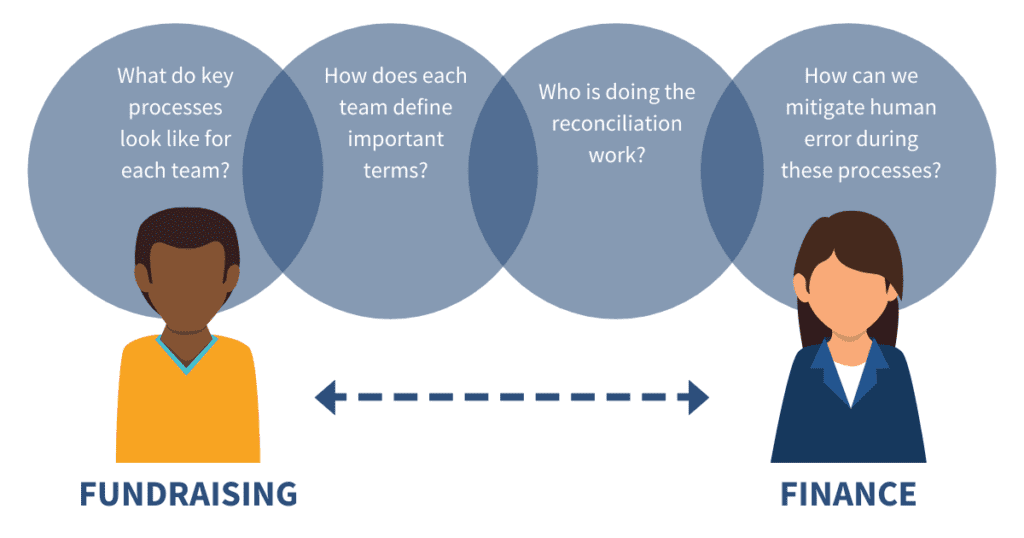Accounting and fundraising are two connected, yet disparate, departments found within most nonprofit organizations. While the departments are intrinsically linked, the data that each side maintains is gathered and utilized for different purposes. Through integrations made possible by Salesforce and tools like Omatic, both accounting and fundraising teams stand to benefit from heightened workflows and greater data clarity. Cloud for Good recently sat down with Stu Manewith, Director of Thought Leadership & Advocacy at Omatic, to discuss the differences and similarities in both accounting and fundraising departments’ technology solutions, and how mindful integrations can pave the way for greater success.
Why is it beneficial for accounting and fundraising departments to operate on two different systems?
Stu Manewith (SM): Typically, accounting and fundraising are recording, tracking, and reporting on very different kinds of data – fundraising needs to capture an enormous amount of biographic, demographic, psychographic, and relational data, as well as activity data, preferences, interaction details, and plans for cultivation, solicitation, and stewardship. All of this in addition to financial and transactional detail. Generally speaking, accounting is only “interested” in the relevant financial information and, depending on the approach taken, may not even want the detail as long as proper detail is maintained in the fundraising system.
How do these department’s priorities differ?
SM: Fundraising’s priorities focus on relationship management and the financial outcomes of effective relationship management, with appropriate targets for growth. Accounting’s priorities are to effectively and accurately record and report on financial activity, ensuring to comply with GAAP (generally accepted accounting principles) and financial accounting standards for nonprofit organizations.
How do these differing priorities affect overall technology goals for a company?
SM: Both groups rely on technology that will ensure efficiency and accuracy and that will provide the required functionality, and both will mutually benefit by integration technology that ensures the effective transfer of relevant transactional data from fundraising to accounting.
We see a lot of fundraisers migrating from Raiser’s Edge to Salesforce. What does it look like when we separate the accounting from fundraising within this system?
SM: Decoupling the systems, and migrating from Raiser’s Edge to Salesforce, will likely provide considerable differences for the Financial Edge team since they have been used to an automated posting process that results in journal entries ready for posting, just like any other subsidiary ledger furnishes. While the posting process will also be different on the fundraising side, now using Salesforce, a new process will need to be put into place to manage and reconcile the transactional data generated by Salesforce and sent over to accounting either in Salesforce reports or in spreadsheets or in files that need to be reformatted and manipulated before being able to be imported into Financial Edge.
In what way can technology integrations fix or circumvent those issues?
SM: Integration solutions such as Salesforce General Ledger Integration powered by Omatic Cloud can ensure that transactional data from Salesforce is extracted and formatted exactly to suit Financial Edge (or any other General Ledger). Omatic’s integration ensures that the right data elements are obtained, in the right format, and that the output file overall is properly formatted for easy, native import into Financial Edge, the outcome being the same as if Financial Edge were connected to Salesforce as tightly as it had been connected to Raiser’s Edge.
What are Omatic’s best practices for ensuring disparate technology integrations coexist together harmoniously?
SM: When Omatic solutions are deployed, organizations rarely need other integration technology. And if any potential changes need to be made in order to ensure data is exchanged healthily and accurately, we have the ability within the integration process itself to transform that data or update that data in the format which is needed by the required system.
Do you find that there are challenges between different terminologies of accounting and fundraising teams? For example, the word “pledge” or “gift” might mean different things depending on the department.
SM: Generally speaking, we’ve found that vernacular and industry-standard terminology is consistent between fundraising and accounting. Occasionally there is a fundraising term that needs to be explained so that accounting can address it with the proper accounting treatment (charitable remainder unitrust) but that’s not commonplace.
How can Omatic help to solve problems of a breakdown in the flow or a breakdown in cross–department communication?
SM: Omatic automates data flow and takes error-prone manual entry and/or manipulation out of the equation. This improves problems tactically but also allows for improved relations between departments. With fewer or no errors or reconciliation issues, the workflow is not hindered, and communications are not fraught.
When is the right time to deploy an organization-wide integration? Who do you believe should be involved in that decision-making process?
SM: If there is no automated integration currently, the time is NOW. Key stakeholders will be different from org to org, but fundraising, gift management, and accounting leaders should be involved.
What do you need internally to ensure these integrations are successful?
SM: Commitment, patience, accountability, and understanding of the needs of the other side.

What does success look like following an integration?
SM: In this particular case: 1) an easy, expedient, and error-free process on the fundraising side, and 2) the accounting side getting exactly what it needs and expects without incident.
While there are several factors to consider before integrating your nonprofit organization’s accounting and fundraising departments, know that the thoughtful execution of such an integration can provide your organization with heightened data clarity and synergy between departments. Technology solutions exist to unburden our business processes and empower the employees that help deliver on nonprofits’ missions. With the right tools, teams, and implementation partners in place, your nonprofit organization stands to advance your unique mission and ensure clear, reliable data across accounting and fundraising departments for years to come.
Learn More about Stu Manewith

For his 30-plus year career, Stu Manewith has exclusively served the nonprofit sector, as a program director, fundraiser, finance director, and technology professional. Stu has also served in several key volunteer roles including board member and chairman of the New Jewish Theatre, board member and national treasurer of Theta Xi Fraternity, and board member and treasurer of the Association of Fundraising Professionals Greater St. Louis Chapter.





